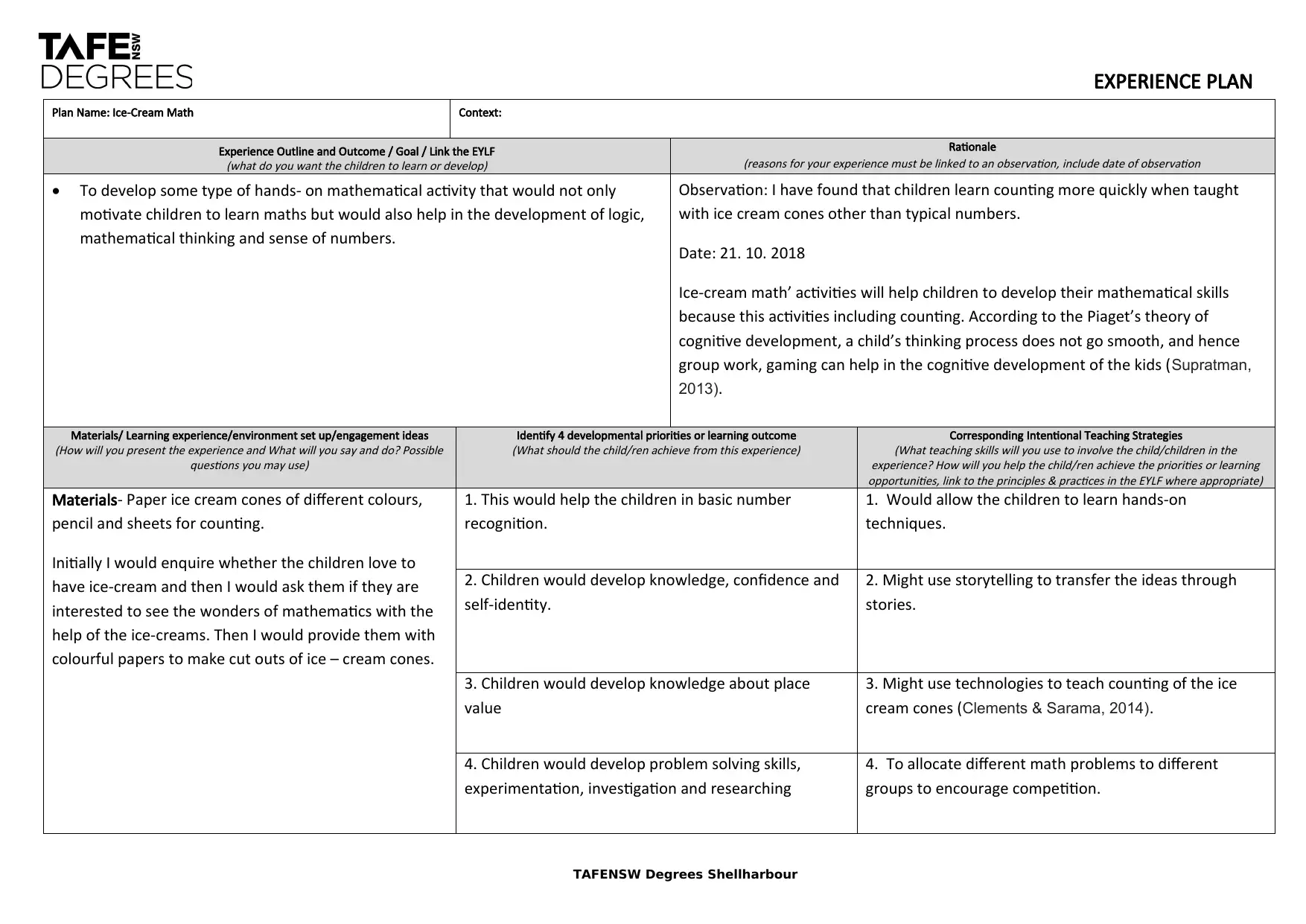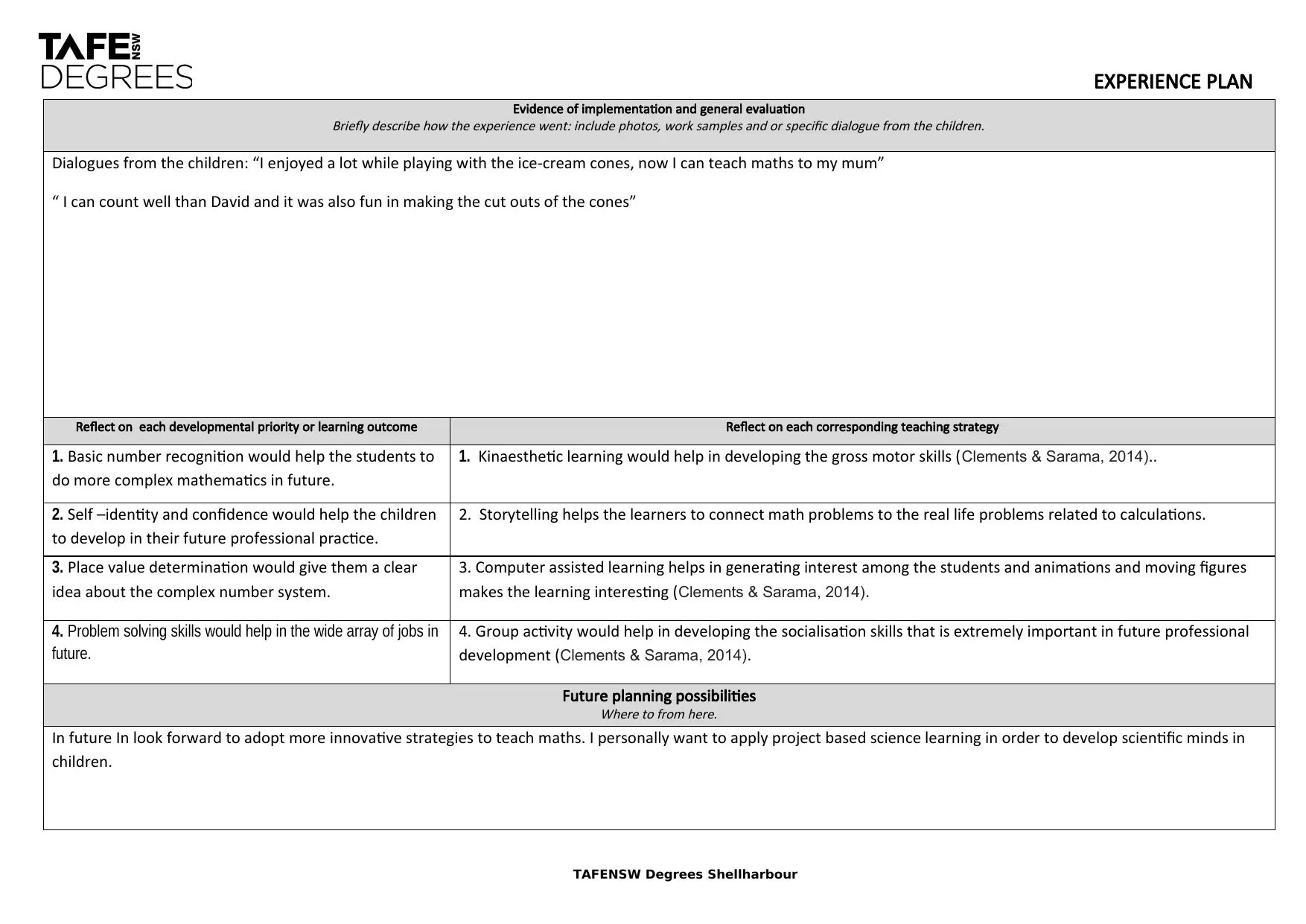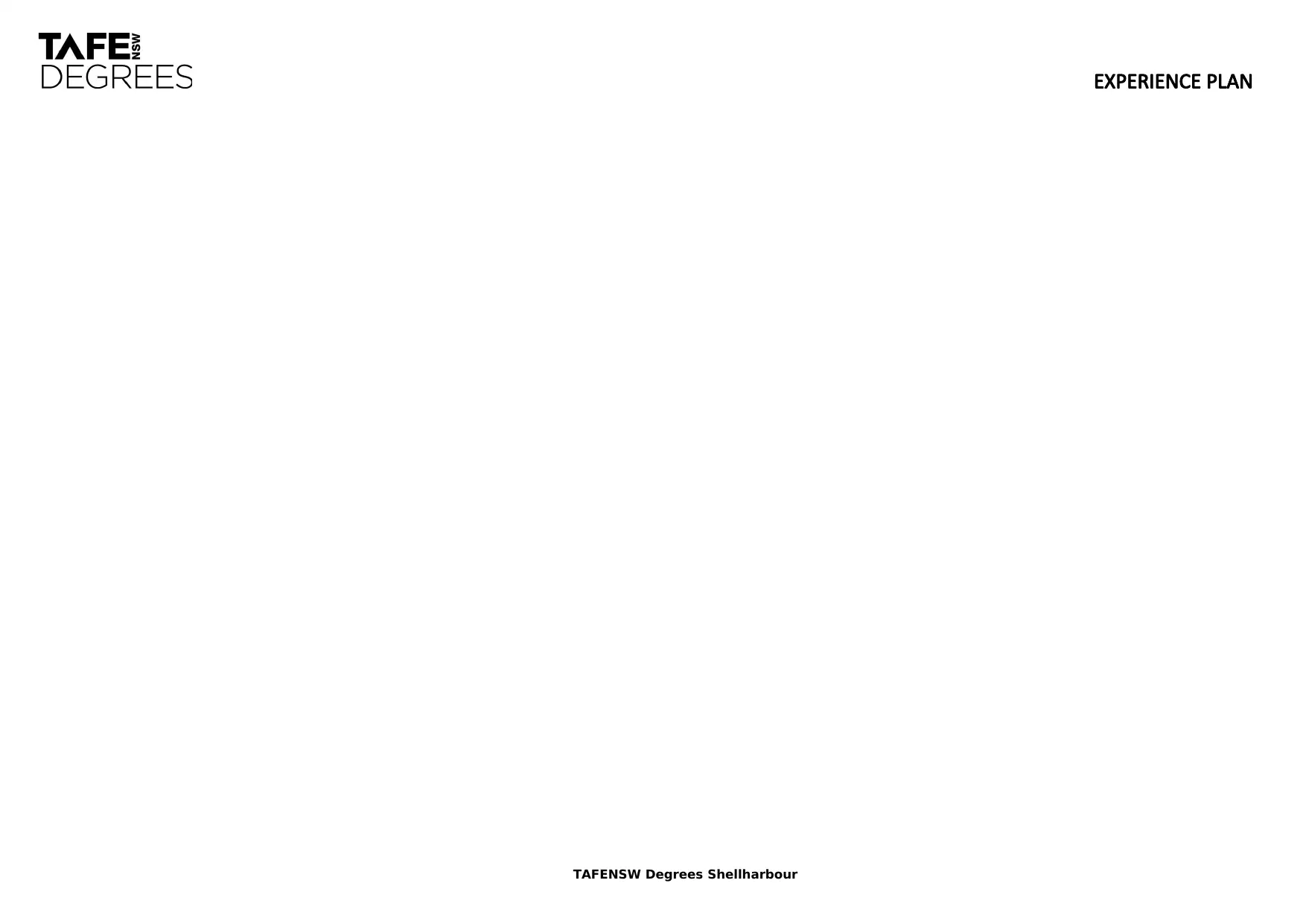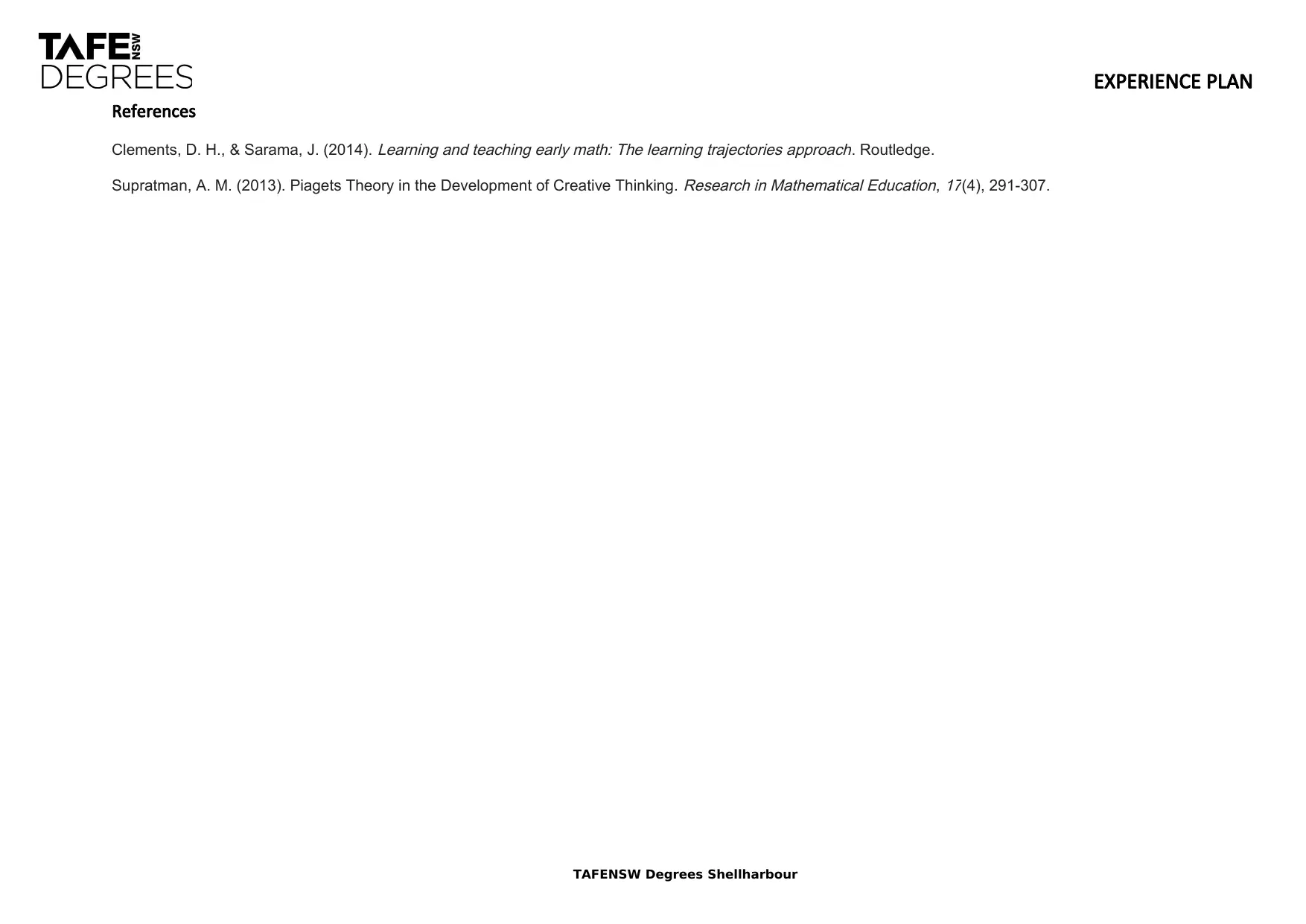Experience Plan: Ice Cream Math to Enhance K12 Math Development
VerifiedAdded on 2023/06/04
|4
|798
|165
Practical Assignment
AI Summary
This assignment details an "Ice Cream Math" experience plan designed to motivate K12 students to learn mathematics through a hands-on activity using colorful ice cream cones. The plan aims to develop number recognition, confidence, place value understanding, and problem-solving skills. It incorporates intentional teaching strategies such as kinaesthetic learning, storytelling, and computer-assisted learning. The plan includes reflections on the experience, student dialogues, and future planning possibilities, emphasizing innovative strategies like project-based science learning. References to relevant research on early math education and cognitive development are also provided. Desklib provides solved assignments and past papers for students.

EXPERIENCE PLAN
Plan Name: Ice-Cream Math Context:
Experience Outline and Outcome / Goal / Link the EYLF
(what do you want the children to learn or develop)
Rationale
(reasons for your experience must be linked to an observation, include date of observation
To develop some type of hands- on mathematical activity that would not only
motivate children to learn maths but would also help in the development of logic,
mathematical thinking and sense of numbers.
Observation: I have found that children learn counting more quickly when taught
with ice cream cones other than typical numbers.
Date: 21. 10. 2018
Ice-cream math’ activities will help children to develop their mathematical skills
because this activities including counting. According to the Piaget’s theory of
cognitive development, a child’s thinking process does not go smooth, and hence
group work, gaming can help in the cognitive development of the kids (Supratman,
2013).
Materials/ Learning experience/environment set up/engagement ideas(How will you present the experience and What will you say and do? Possible
questions you may use)
Identify 4 developmental priorities or learning outcome
(What should the child/ren achieve from this experience)
Corresponding Intentional Teaching Strategies
(What teaching skills will you use to involve the child/children in the
experience? How will you help the child/ren achieve the priorities or learning
opportunities, link to the principles & practices in the EYLF where appropriate)
Materials- Paper ice cream cones of different colours,
pencil and sheets for counting.
Initially I would enquire whether the children love to
have ice-cream and then I would ask them if they are
interested to see the wonders of mathematics with the
help of the ice-creams. Then I would provide them with
colourful papers to make cut outs of ice – cream cones.
1. This would help the children in basic number
recognition.
1. Would allow the children to learn hands-on
techniques.
2. Children would develop knowledge, confidence and
self-identity.
2. Might use storytelling to transfer the ideas through
stories.
3. Children would develop knowledge about place
value
3. Might use technologies to teach counting of the ice
cream cones (Clements & Sarama, 2014).
4. Children would develop problem solving skills,
experimentation, investigation and researching
4. To allocate different math problems to different
groups to encourage competition.
TAFENSW Degrees Shellharbour
Plan Name: Ice-Cream Math Context:
Experience Outline and Outcome / Goal / Link the EYLF
(what do you want the children to learn or develop)
Rationale
(reasons for your experience must be linked to an observation, include date of observation
To develop some type of hands- on mathematical activity that would not only
motivate children to learn maths but would also help in the development of logic,
mathematical thinking and sense of numbers.
Observation: I have found that children learn counting more quickly when taught
with ice cream cones other than typical numbers.
Date: 21. 10. 2018
Ice-cream math’ activities will help children to develop their mathematical skills
because this activities including counting. According to the Piaget’s theory of
cognitive development, a child’s thinking process does not go smooth, and hence
group work, gaming can help in the cognitive development of the kids (Supratman,
2013).
Materials/ Learning experience/environment set up/engagement ideas(How will you present the experience and What will you say and do? Possible
questions you may use)
Identify 4 developmental priorities or learning outcome
(What should the child/ren achieve from this experience)
Corresponding Intentional Teaching Strategies
(What teaching skills will you use to involve the child/children in the
experience? How will you help the child/ren achieve the priorities or learning
opportunities, link to the principles & practices in the EYLF where appropriate)
Materials- Paper ice cream cones of different colours,
pencil and sheets for counting.
Initially I would enquire whether the children love to
have ice-cream and then I would ask them if they are
interested to see the wonders of mathematics with the
help of the ice-creams. Then I would provide them with
colourful papers to make cut outs of ice – cream cones.
1. This would help the children in basic number
recognition.
1. Would allow the children to learn hands-on
techniques.
2. Children would develop knowledge, confidence and
self-identity.
2. Might use storytelling to transfer the ideas through
stories.
3. Children would develop knowledge about place
value
3. Might use technologies to teach counting of the ice
cream cones (Clements & Sarama, 2014).
4. Children would develop problem solving skills,
experimentation, investigation and researching
4. To allocate different math problems to different
groups to encourage competition.
TAFENSW Degrees Shellharbour
Paraphrase This Document
Need a fresh take? Get an instant paraphrase of this document with our AI Paraphraser

EXPERIENCE PLAN
Evidence of implementation and general evaluation
Briefly describe how the experience went: include photos, work samples and or specific dialogue from the children.
Dialogues from the children: “I enjoyed a lot while playing with the ice-cream cones, now I can teach maths to my mum”
“ I can count well than David and it was also fun in making the cut outs of the cones”
Reflect on each developmental priority or learning outcome Reflect on each corresponding teaching strategy
1. Basic number recognition would help the students to
do more complex mathematics in future.
1. Kinaesthetic learning would help in developing the gross motor skills (Clements & Sarama, 2014)..
2. Self –identity and confidence would help the children
to develop in their future professional practice.
2. Storytelling helps the learners to connect math problems to the real life problems related to calculations.
3. Place value determination would give them a clear
idea about the complex number system.
3. Computer assisted learning helps in generating interest among the students and animations and moving figures
makes the learning interesting (Clements & Sarama, 2014).
4. Problem solving skills would help in the wide array of jobs in
future.
4. Group activity would help in developing the socialisation skills that is extremely important in future professional
development (Clements & Sarama, 2014).
Future planning possibilities
Where to from here.
In future In look forward to adopt more innovative strategies to teach maths. I personally want to apply project based science learning in order to develop scientific minds in
children.
TAFENSW Degrees Shellharbour
Evidence of implementation and general evaluation
Briefly describe how the experience went: include photos, work samples and or specific dialogue from the children.
Dialogues from the children: “I enjoyed a lot while playing with the ice-cream cones, now I can teach maths to my mum”
“ I can count well than David and it was also fun in making the cut outs of the cones”
Reflect on each developmental priority or learning outcome Reflect on each corresponding teaching strategy
1. Basic number recognition would help the students to
do more complex mathematics in future.
1. Kinaesthetic learning would help in developing the gross motor skills (Clements & Sarama, 2014)..
2. Self –identity and confidence would help the children
to develop in their future professional practice.
2. Storytelling helps the learners to connect math problems to the real life problems related to calculations.
3. Place value determination would give them a clear
idea about the complex number system.
3. Computer assisted learning helps in generating interest among the students and animations and moving figures
makes the learning interesting (Clements & Sarama, 2014).
4. Problem solving skills would help in the wide array of jobs in
future.
4. Group activity would help in developing the socialisation skills that is extremely important in future professional
development (Clements & Sarama, 2014).
Future planning possibilities
Where to from here.
In future In look forward to adopt more innovative strategies to teach maths. I personally want to apply project based science learning in order to develop scientific minds in
children.
TAFENSW Degrees Shellharbour

EXPERIENCE PLAN
TAFENSW Degrees Shellharbour
TAFENSW Degrees Shellharbour
⊘ This is a preview!⊘
Do you want full access?
Subscribe today to unlock all pages.

Trusted by 1+ million students worldwide

EXPERIENCE PLAN
References
Clements, D. H., & Sarama, J. (2014).
Learning and teaching early math: The learning trajectories approach. Routledge.
Supratman, A. M. (2013). Piagets Theory in the Development of Creative Thinking.
Research in Mathematical Education,
17(4), 291-307.
TAFENSW Degrees Shellharbour
References
Clements, D. H., & Sarama, J. (2014).
Learning and teaching early math: The learning trajectories approach. Routledge.
Supratman, A. M. (2013). Piagets Theory in the Development of Creative Thinking.
Research in Mathematical Education,
17(4), 291-307.
TAFENSW Degrees Shellharbour
1 out of 4
Related Documents
Your All-in-One AI-Powered Toolkit for Academic Success.
+13062052269
info@desklib.com
Available 24*7 on WhatsApp / Email
![[object Object]](/_next/static/media/star-bottom.7253800d.svg)
Unlock your academic potential
Copyright © 2020–2025 A2Z Services. All Rights Reserved. Developed and managed by ZUCOL.




